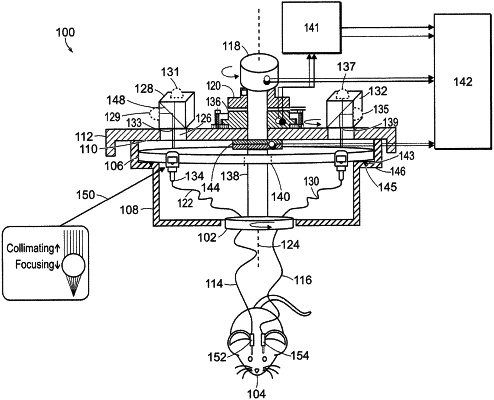| CPC G02B 6/3604 (2013.01) [A01K 29/005 (2013.01); A61B 5/6868 (2013.01); A61N 5/0622 (2013.01)] | 20 Claims |

|
1. An automated fiber optic rotary joint, comprising:
a processor;
an electric motor communicably coupled to the processor for control thereby;
a shaft mechanically coupled to the electric motor for rotation thereby;
a sensor configured to detect angular position of the shaft and communicably coupled to the processor to provide information about the angular position of the shaft to the processor;
a first arm rigidly attached to the shaft for rotation therewith;
a second arm axially spaced apart from the first arm and coaxially disposed about the shaft, such that the shaft can rotate independently of the second arm;
a clutch coupled to the processor for control thereby and configured to mechanically couple the second arm to the shaft for rotation therewith, when the clutch is engaged;
an interlocking mechanism configured to maintain a position of the second arm when the clutch is disengaged;
a first optical element having a first port, a second port and a common port; and
a first optical fiber extending between the first arm and the second arm, such that at a predetermined angular position of the second arm, a first end of the first optical fiber is optically aligned with a first port and a second port of the first optical element via a common port of the first optical element;
wherein the processor is configured to automatically use the information about the angular position of the shaft to determine whether the first arm has rotated by at least a first predetermined amount and, if the processor detects that the shaft has rotated by at least the first predetermined amount:
cause the clutch to engage;
cause the motor to rotate the shaft a second predetermined amount in a direction same as rotation of the first arm; and
cause the clutch to disengage.
|